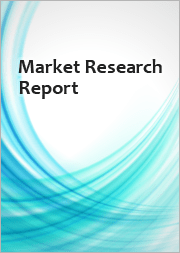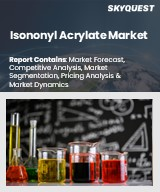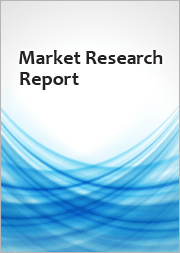
|
시장보고서
상품코드
1736921
세계의 부틸 아크릴레이트 시장 규모 : 제품별, 순도별, 용도별, 지역 범위별 및 예측Global Butyl Acrylate Market Size By Product, By Purity, By Application, By Geographic Scope And Forecast |
||||||
부틸 아크릴레이트 시장 규모 및 예측
부틸 아크릴레이트 시장 규모는 2024년에 65억 1,000만 달러로 평가되었고, 2026-2032년 5%의 연평균 복합 성장률(CAGR)로 성장하여 2032년에는 92억 8,000만 달러에 달할 것으로 예측됩니다.
세계의 부틸 아크릴레이트 시장 보고서는 예측 기간 동안 시장의 전반적인 평가를 기술하고 있습니다. 이 보고서는 다양한 부문와 시장에서 중요한 역할을 하는 동향 및 요인에 대한 분석으로 구성되어 있습니다. 이러한 요인은 시장 성장 촉진요인, 억제요인, 기회 및 과제이며, 이러한 요인이 시장에 미치는 영향을 개괄적으로 설명합니다. 시장 성장 촉진요인 및 과제가 시장의 외재적 요인인 반면, 시장 성장 촉진요인 및 억제요인은 내재적 요인입니다. 세계의 부틸 아크릴레이트 시장 조사 보고서는 예측 기간 동안 수익 측면의 개발 전망을 설명합니다.
부틸 아크릴레이트 시장 규모 및 예측
부틸 아크릴레이트 시장 규모는 2024년 65억 1,000만 달러로 평가되었고, 2026-2032년 연평균 복합 성장률(CAGR) 5%로 성장하여 2032년에는 92억 8,000만 달러에 달할 것으로 예측됩니다.
세계의 부틸 아크릴레이트 시장 보고서는 예측 기간 동안 시장의 전반적인 평가를 기술하고 있습니다. 이 보고서는 다양한 부문와 시장에서 중요한 역할을 하는 동향 및 요인에 대한 분석으로 구성되어 있습니다. 이러한 요인은 시장 성장 촉진요인, 억제요인, 기회 및 과제이며, 이러한 요인이 시장에 미치는 영향을 개괄적으로 설명합니다. 시장 성장 촉진요인 및 과제가 시장의 외재적 요인인 반면, 시장 성장 촉진요인 및 억제요인은 내재적 요인입니다. 세계의 부틸 아크릴레이트 시장에 대한 조사 보고서는 예측 기간 동안 수익 측면의 개발 전망을 기술하고 있습니다.
세계의 부틸 아크릴레이트 시장 성장 억제요인
몇 가지 요인이 부틸 아크릴레이트 시장 성장 억제요인 또는 과제로 작용할 수 있습니다. 여기에는 다음과 같은 것들이 포함됩니다.
원료 가격 변동 부틸 아크릴레이트 생산에 사용되는 두 가지 원료인 부탄올과 아크릴산의 가격 변동은 제조업체의 이익률과 생산 비용에 영향을 미칠 수 있습니다. 가격의 불안정성과 시장 확대는 예측할 수 없는 원료 비용에 기인할 수 있습니다.
엄격한 환경 규제: 부틸 아크릴레이트 시장은 휘발성 유기 화합물(VOC) 및 위험한 대기 오염 물질의 배출량을 줄이기 위한 규제로 인해 어려움에 직면해 있습니다. 엄격한 환경 기준을 준수하기 위해 배출 억제 기술 및 대체 배합에 투자해야 하기 때문에 생산자의 운영 비용이 상승할 수 있습니다.
건강 및 안전 문제: 고농도 부틸 아크릴레이트는 피부, 눈, 호흡기를 자극합니다. 위험 화학물질로 분류됩니다. 부틸 아크릴레이트의 취급, 보관 및 운송에 대해서는 산업안전보건기준에 따라 엄격한 가이드라인이 정해져 있습니다. 이 때문에 기업은 규제의 감시를 받게 되며, 규정 준수 비용이 상승할 수 있습니다.
대체품에 의한 대체: 일부 용도에 따라 부틸 아크릴레이트과 동등한 특성을 가진 메타크릴레이트나 아크릴산 에스테르와 같은 대체 단량체 및 화합물을 사용할 수 있기 때문에 대체품의 위험이 있습니다. 부틸 아크릴레이트 시장 점유율은 대체품이 비용, 성능, 규제 준수 측면에서 경쟁 우위를 제공할 수 있기 때문에 감소할 수 있습니다.
최종 이용 산업의 둔화: 부틸 아크릴레이트 기반 제품 시장은 섬유, 자동차, 건설 등 주요 최종 이용 산업의 경기 침체, 지정학적 불안, 경기 침체의 영향을 받을 수 있습니다. 개인 소비, 자동차 생산, 건설 활동의 감소는 시장 확대를 저해할 수 있습니다.
과잉 생산 능력과 가격 경쟁: 과잉 생산 능력 또는 새로운 경쟁으로 인해 부틸 아크릴레이트 시장은 과잉 생산 능력을 갖게 되고, 생산자 간 가격 경쟁이 심화될 수 있습니다. 가격 압력은 이윤율을 낮추고 기술 혁신과 역량 개발에 대한 투자를 저해할 수 있습니다.
무역장벽 및 관세: 정부의 보호무역주의 조치, 관세, 무역 분쟁은 세계 무역을 저해하고 부틸 아크릴레이트 제조업체의 수출입 비용을 상승시킬 수 있습니다. 무역 제한은 공급망 역학에 영향을 미치고 시장 접근을 제한하며 경쟁을 저해할 수 있습니다.
기술적 제약: 제조업체는 공정 기술, 촉매, 생산 효율의 한계로 인해 부틸 아크릴레이트의 생산 수율, 품질, 비용을 최적화하지 못할 수 있습니다. 기업이 이러한 장애물을 극복하고 시장 경쟁력을 유지하기 위해서는 기술 개발이 필수적입니다.
고객 선호도 변화: 부틸 아크릴레이트 아크릴산 함유 제품 시장은 친환경 제품, 바이오 대체품, 특수 용도 등 소비자의 선호도 변화에 영향을 받을 수 있습니다. 성장을 유지하기 위해 생산자는 소비자의 선호도 변화 및 개발에 대응해야 합니다.
지정학적 리스크와 공급망 혼란: 자연재해, 지정학적 사건, 지정학적 긴장은 모두 원자재 및 완제품의 가용성에 영향을 미치고, 공급망과 생산 활동을 중단시킬 수 있습니다. 공급망의 혼란은 시장의 안정성과 공급의 연속성을 위험에 빠뜨릴 수 있습니다.
부틸 아크릴레이트 시장 세분화 분석
세계의 부틸 아크릴레이트 시장은 제품, 순도, 용도, 지역별로 분류됩니다.
부틸 아크릴레이트 시장, 제품별
- I-Butyl Acrylate: isobutyl group을 특징으로 하는 부틸 아크릴레이트의 제품 유형으로 페인트, 코팅제, 접착제, 플라스틱 첨가제 제조에 일반적으로 사용됩니다.
- N-Butyl Acrylate: n-butyl group을 특징으로 하는 부틸 아크릴레이트의 변종으로 접착제, 실란트, 화학합성, 섬유용 코팅제 제조에 널리 사용됩니다.
- T-Butyl Acrylate: tert-butyl group을 가진 부틸 아크릴레이트 유도체로 독특한 화학적 특성으로 페인트, 코팅제, 플라스틱, 화학합성 등 다양한 용도로 활용되고 있습니다.
부틸 아크릴레이트 시장, 순도별
- 고순도: 매우 높은 순도의 부틸 아크릴레이트는 전자, 제약, 정밀화학 등의 산업에서 특수 용도에 적합합니다.
- 일반 순도: 표준 수준의 순도를 가진 부틸 아크릴레이트. 페인트, 코팅제, 접착제, 섬유 등의 산업에서 범용적으로 사용할 수 있습니다.
부틸 아크릴레이트 시장, 용도별
- 페인트 및 코팅 부틸 아크릴레이트는 건축, 자동차, 산업, 장식용 페인트, 코팅제, 마감제 배합의 주요 성분으로 활용되고 있습니다.
- 접착제 및 실란트: 건축, 자동차 조립, 포장, 제조에 사용되는 접착제, 실란트, 접합제 제조에 사용되는 부틸 아크릴레이트.
- 화학 합성: 부틸 아크릴레이트는 화학 합성 공정에서 다양한 산업을 위한 광범위한 중간체, 단량체, 폴리머, 폴리머, 특수 화학제품을 생산하기 위해 활용됩니다.
- 플라스틱 첨가제 : 부틸 아크릴레이트는 가소제, 개질제, 수지 성분으로 플라스틱, 폴리머, 복합재료의 제조에 사용되어 성능, 유연성, 내구성을 향상시킵니다.
- 섬유제품: 발수성, 방오성, 내구성, 견뢰도 등의 특성을 직물이나 섬유에 부여하기 위해 섬유용 코팅제, 마감제, 처리제에 사용되는 부틸 아크릴레이트.
- 지역별
- 북미: 미국, 캐나다, 멕시코 시장 상황과 수요.
- 유럽 유럽 국가의 부틸 아크릴레이트 시장 분석.
- 아시아태평양: 중국, 인도, 일본, 한국 등의 국가에 집중합니다.
- 중동 및 아프리카: 중동 및 아프리카 시장 역학을 살펴봅니다.
- 라틴아메리카: 라틴아메리카 각국 시장 동향과 개척.
주요 진출 기업
- The major players in the Butyl Acrylate Market are:
- BASF SE
- Dow Chemical Company
- Arkema
- LG Chem, Ltd.
- Formosa Plastics Corporation
- Saudi Acrylic Monomers Company (SAMCO)
- Shanghai Huayi Acrylic Acid Co., Ltd
- PETRONAS Chemicals Group Berhad (PCG)
- Zhejiang Satellite Petrochemical Co., Ltd.
- Oita Chemical Co., Ltd.
목차
제1장 세계의 부틸 아크릴레이트 시장 서론
- 시장 개요
- 조사 범위
- 전제조건
제2장 주요 요약
제3장 VERIFIED MARKET RESEARCH의 조사 방법
- 데이터 마이닝
- 밸리데이션
- 1차 자료
- 데이터 소스 리스트
제4장 세계의 부틸 아크릴레이트 시장 전망
- 개요
- 시장 역학
- 성장 촉진요인
- 성장 억제요인
- 기회
- Porter's Five Forces 모델
- 밸류체인 분석
제5장 세계의 부틸 아크릴레이트 시장 : 제품별
- 개요
- I-Butyl Acrylate
- N-Butyl Acrylate
- T-Butyl Acrylate
제6장 세계의 부틸 아크릴레이트 시장 : 순도별
- 개요
- 고순도
- 일반 순도
제7장 세계의 부틸 아크릴레이트 시장 : 용도별
- 개요
- 페인트 및 코팅
- 접착제 및 실란트
- 화학 합성
- 플라스틱 첨가제
- 섬유 제품
- 기타
제8장 세계의 부틸 아크릴레이트 시장 : 지역별
- 개요
- 북미
- 미국
- 캐나다
- 멕시코
- 유럽
- 독일
- 영국
- 프랑스
- 기타 유럽
- 아시아태평양
- 중국
- 일본
- 인도
- 기타 아시아태평양
- 기타
- 라틴아메리카
- 중동
제9장 세계의 부틸 아크릴레이트 시장 경쟁 구도
- 개요
- 기업의 시장 순위
- 주요 개발 전략
제10장 기업 개요
- BASF SE
- Dow Chemical Company
- Arkema
- LG Chem, Ltd.
- Formosa Plastics Corporation
- Saudi Acrylic Monomers Company(SAMCO)
- Shanghai Huayi Acrylic Acid Co., Ltd
- PETRONAS Chemicals Group Berhad(PCG)
- Zhejiang Satellite Petrochemical Co., Ltd.
- Oita Chemical Co., Ltd.
제11장 부록
- 관련 조사
Butyl Acrylate Market Size And Forecast
Butyl Acrylate Market size was valued at USD 6.51 Billion in 2024 and is projected to reach USD 9.28 Billion by 2032, growing at a CAGR of 5% from 2026 to 2032.
The Global Butyl Acrylate Market report provides a holistic evaluation of the market for the forecast period. The report comprises various segments as well as an analysis of the trends and factors that are playing a substantial role in the market. These factors; the market dynamics involve the drivers, restraints, opportunities, and challenges through which the impact of these factors in the market is outlined. The drivers and restraints are intrinsic factors whereas opportunities and challenges are extrinsic factors of the market. The Global Butyl Acrylate Market study provides an outlook on the development of the market in terms of revenue throughout the prognosis period.
Butyl Acrylate Market Size And Forecast
Butyl Acrylate Market size was valued at USD 6.51 Billion in 2024 and is projected to reach USD 9.28 Billion by 2032, growing at a CAGR of 5% from 2026 to 2032.
The Global Butyl Acrylate Market report provides a holistic evaluation of the market for the forecast period. The report comprises various segments as well as an analysis of the trends and factors that are playing a substantial role in the market. These factors; the market dynamics involve the drivers, restraints, opportunities, and challenges through which the impact of these factors in the market is outlined. The drivers and restraints are intrinsic factors whereas opportunities and challenges are extrinsic factors of the market. The Global Butyl Acrylate Market study provides an outlook on the development of the market in terms of revenue throughout the prognosis period.
Global Butyl Acrylate Market Restraints
Several factors can act as restraints or challenges for the Butyl Acrylate Market. These may include:
Volatility in Raw Material Prices: Changes in the cost of butanol and acrylic acid, two raw materials used to produce butyl acrylate, can have an effect on manufacturers' profit margins and production costs. Price instability and market expansion may result from unpredictable raw material costs.
Tight Environmental Regulations: The market for butyl acrylate faces difficulties as a result of regulations designed to lower emissions of volatile organic compounds (VOCs) and dangerous air pollutants. Producers' operating costs may rise as a result of having to invest in emission control technologies and alternative formulations to comply with tight environmental standards.
Health and Safety Concerns: High concentrations of butyl acrylate can irritate the skin, eyes, and respiratory system. It is categorised as a hazardous chemical. Strict guidelines for the handling, storing, and transportation of butyl acrylate are enforced by occupational health and safety standards. This can put firms under more regulatory scrutiny and raise compliance costs.
Substitution by Alternatives: In some applications, there is a risk of substitution due to the availability of substitute monomers and compounds like methacrylates and acrylate esters that have characteristics comparable to those of butyl acrylate. Butyl acrylate's market share may decline as a result of substitutes' potential to provide competitive benefits in terms of cost, performance, or regulatory compliance.
Slowdown in End-Use Industries: The market for products based on butyl acrylate may be impacted by cyclical downturns, geopolitical unrest, and economic downturns in important end-use industries like textiles, automobiles, and construction. Decreases in consumer spending, automobile production, or construction activity could impede market expansion.
Overcapacity and Price Competitiveness: Excess production capacity or new competitors may cause the butyl acrylate market to become overcapacitated, which may increase price competitiveness among producers. Price pressures have the potential to reduce profit margins and impede investments in technical innovation and capacity development.
Trade Barriers and Tariffs: Government-imposed protectionist policies, tariffs, and trade disputes can impede global trade and raise import/export expenses for butyl acrylate manufacturers. Trade restrictions can impact supply chain dynamics, restrict market access, and impede competitiveness.
Technological Constraints: Manufacturers may not be able to optimise butyl acrylate manufacturing yields, quality, and costs due to limitations in process technologies, catalysts, or production efficiency. For businesses to overcome these obstacles and remain competitive in the market, technological developments are essential.
Altering Customer Preferences: The market for items containing butyl acrylate may be impacted by shifting consumer preferences, such as those for eco-friendly goods, bio-based substitutes, or specialised uses. To maintain growth, producers must adjust to changing consumer tastes and market developments.
Geopolitical Risks and Supply Chain Disruptions: Natural catastrophes, geopolitical events, and geopolitical tensions can all affect the availability of raw materials and completed goods, as well as interrupt supply chains and production activities. Disruptions to the supply chain put the stability of the market and supply continuity at risk.
Butyl Acrylate Market Segmentation Analysis
The Global Butyl Acrylate Market is Segmented on the basis of Product, Purity, Application, And Geography.
Butyl Acrylate Market, By Product
- I-Butyl Acrylate: A type of butyl acrylate characterized by its isobutyl group, commonly used in the production of paints, coatings, adhesives, and plastic additives.
- N-Butyl Acrylate: A variant of butyl acrylate featuring the n-butyl group, widely employed in the manufacturing of adhesives, sealants, chemical synthesis, and textile coatings.
- T-Butyl Acrylate: A butyl acrylate derivative containing the tert-butyl group, utilized in various applications including paints, coatings, plastics, and chemical synthesis due to its unique chemical properties.
Butyl Acrylate Market, By Purity
- High Purity: Butyl acrylate with exceptionally high levels of purity, suitable for specialized applications in industries such as electronics, pharmaceuticals, and fine chemicals.
- Common Purity: Butyl acrylate with standard levels of purity suitable for general-purpose applications in industries such as paints, coatings, adhesives, and textiles.
Butyl Acrylate Market, By Application
- Paints and Coatings: Butyl acrylate utilized as a key ingredient in the formulation of paints, coatings, and finishes for architectural, automotive, industrial, and decorative applications.
- Adhesives and Sealants: Butyl acrylate employed in the production of adhesives, sealants, and bonding agents used in construction, automotive assembly, packaging, and manufacturing.
- Chemical Synthesis: Butyl acrylate utilized in chemical synthesis processes to produce a wide range of intermediates, monomers, polymers, and specialty chemicals for various industries.
- Plastic Additives: Butyl acrylate incorporated as a plasticizer, modifier, or resin component in the production of plastics, polymers, and composite materials to enhance performance, flexibility, and durability.
- Textiles: Butyl acrylate applied in textile coatings, finishes, and treatments to impart properties such as water repellency, stain resistance, durability, and color fastness to fabrics and fibers.
- By Geography
- North America: Market conditions and demand in the United States, Canada, and Mexico.
- Europe: Analysis of the Butyl Acrylate Market in European countries.
- Asia-Pacific: Focusing on countries like China, India, Japan, South Korea, and others.
- Middle East and Africa: Examining market dynamics in the Middle East and African regions.
- Latin America: Covering market trends and developments in countries across Latin America.
Key Players
- The major players in the Butyl Acrylate Market are:
- BASF SE
- Dow Chemical Company
- Arkema
- LG Chem, Ltd.
- Formosa Plastics Corporation
- Saudi Acrylic Monomers Company (SAMCO)
- Shanghai Huayi Acrylic Acid Co., Ltd
- PETRONAS Chemicals Group Berhad (PCG)
- Zhejiang Satellite Petrochemical Co., Ltd.
- Oita Chemical Co., Ltd.
TABLE OF CONTENTS
1 INTRODUCTION OF GLOBAL BUTYL ACRYLATE MARKET
- 1.1 Overview of the Market
- 1.2 Scope of Report
- 1.3 Assumptions
2 EXECUTIVE SUMMARY
3 RESEARCH METHODOLOGY OF VERIFIED MARKET RESEARCH
- 3.1 Data Mining
- 3.2 Validation
- 3.3 Primary Interviews
- 3.4 List of Data Sources
4 GLOBAL BUTYL ACRYLATE MARKET OUTLOOK
- 4.1 Overview
- 4.2 Market Dynamics
- 4.2.1 Drivers
- 4.2.2 Restraints
- 4.2.3 Opportunities
- 4.3 Porters Five Force Model
- 4.4 Value Chain Analysis
5 GLOBAL BUTYL ACRYLATE MARKET, BY PRODUCT
- 5.1 Overview
- 5.2 I-Butyl Acrylate
- 5.3 N-Butyl Acrylate
- 5.4 T-Butyl Acrylate
6 GLOBAL BUTYL ACRYLATE MARKET, BY PURITY
- 6.1 Overview
- 6.2 High Purity
- 6.3 Common Purity
7 GLOBAL BUTYL ACRYLATE MARKET, BY APPLICATION
- 7.1 Overview
- 7.2 Paints and Coatings
- 7.3 Adhesives and Sealants
- 7.4 Chemical Synthesis
- 7.5 Plastic Additives
- 7.6 Textiles
- 7.7 Others
8 GLOBAL BUTYL ACRYLATE MARKET, BY GEOGRAPHY
- 8.1 Overview
- 8.2 North America
- 8.2.1 U.S.
- 8.2.2 Canada
- 8.2.3 Mexico
- 8.3 Europe
- 8.3.1 Germany
- 8.3.2 U.K.
- 8.3.3 France
- 8.3.4 Rest of Europe
- 8.4 Asia Pacific
- 8.4.1 China
- 8.4.2 Japan
- 8.4.3 India
- 8.4.4 Rest of Asia Pacific
- 8.5 Rest of the World
- 8.5.1 Latin America
- 8.5.2 Middle East
9 GLOBAL BUTYL ACRYLATE MARKET COMPETITIVE LANDSCAPE
- 9.1 Overview
- 9.2 Company Market Ranking
- 9.3 Key Development Strategies
10 COMPANY PROFILES
BASF SE
Dow Chemical Company
Arkema
LG Chem, Ltd.
Formosa Plastics Corporation
Saudi Acrylic Monomers Company (SAMCO)
Shanghai Huayi Acrylic Acid Co., Ltd
PETRONAS Chemicals Group Berhad (PCG)
Zhejiang Satellite Petrochemical Co., Ltd.
Oita Chemical Co., Ltd.
11 Appendix
- 11.1 Related Research



















